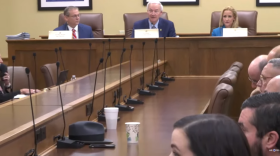During a hearing that lasted less than a half-hour, members of the Arkansas Board of Apportionment gave final approval Monday to new district maps for the state House of Representatives and Senate. But Gov. Asa Hutchinson, one of the board's three members, acknowledged the maps could face legal challenges.
The Arkansas Public Policy Panel and the Arkansas Citizen’s First Congress on Friday released a 45-page analysis suggesting the maps were illegally gerrymandered with boundaries unnecessarily dividing cities to “marginalize the ability of racial and ethnic groups to influence” election outcomes. The American Civil Liberties Union also last week sent a third letter to the board arguing the maps violate the federal Voting Rights Act of 1965.
The Board of Apportionment is made up of the governor, Attorney General Leslie Rutledge and Secretary of State John Thurston, all Republicans. The districts are redrawn every 10 years after U.S. Census counts are complete.
“There’s probably not a perfect process for redistricting, but through the guidance of the courts, federal law, the Constitution, I believe in Arkansas, we managed it as well as any state could,” Hutchinson said after two unanimous votes approving maps for each chamber of the legislature. “Nothing’s perfect, but I think our system has worked well this time. I think it obviously can be reviewed by the courts.”
Final approval of the maps came after a 30-day public comment period that followed the board’s previous meeting on Oct. 29. Hutchinson on Monday listed several changes that had been made to the maps based on comments that were received.
He said the board’s staff redrew House district boundaries to make the city of Mountain Home whole, made changes to districts around Jonesboro, Fort Smith and Hermitage, and adjusted House District 9 in Springdale so that it is now a majority Latino voting age district.
On the Senate map, Hutchinson said changes were made to keep Hot Springs Village whole, removed boundaries that would have split Stone and Searcy counties, modified a district in Fort Smith and kept the number of districts with minorities making up the majority of voters at four.

“I see those are responding more broadly to some needs and it really illustrates how important this 30-day comment period has been,” Hutchinson said. “I know that all of the concerns expressed have not been able to be adjusted, and again, there are broader reasons in terms of the entire map that constrained our action in that regard.”
No immediate lawsuits were announced after Monday’s meeting, but the Democratic Party of Arkansas Chair Grant Tennille suggested legal action will be forthcoming. He said in a press release that the new maps will decrease majority-minority districts 17.6%.
“They cracked minority populations along the Delta, diluting Black votes and weakening Black incumbents along the Mississippi River and in South Arkansas — while also packing minority populations elsewhere," Tennille said. "These newly drawn maps are illegal. The people who drew them know it, and they know they’ll be headed to court.”
Rutledge said at the end of the meeting that the maps will withstand any challenges.
“I am confident as the state’s lawyer that when we look at these maps that these maps meet all of the requirements of federal law," Rutledge said. "They are fair, equal and are in the best interest of the citizens of Arkansas.”
Hutchinson also expressed confidence in the legitimacy of the process.
“We did all that we could to follow the Constitution and the public comments and to do it in a way that provides for equal representation, and that is the goal that we all have,” Hutchinson said. “I’m pleased with the process. I know there will be a debate and review of this as we go into the future, but [I’m] grateful to the people of the State of Arkansas for allowing us this opportunity to shape equal representation for our state for the next decade.”
In a joint statement Monday afternoon, the Arkansas Public Policy Panel and the Arkansas Citizen’s First Congress said, "We will continue to review the impact of the sudden changes in the maps, but overall our previous assessment remains valid: Communities across Arkansas are unnecessarily split to serve a political outcome. The Board failed to sufficiently inform and engage the public. And the Board ignored most of the rules spelled out in law on how the maps should be drawn."
This story has been revised to include reaction after Monday's meeting of the Arkansas Board of Apportionment.





